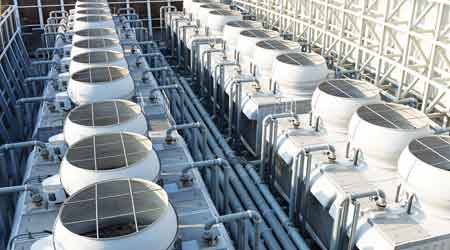Water Management Plan Goes Beyond Legionella
Legionnaire’s Disease makes the news, but that doesn’t mean it’s the only water management concern.
Don’t get caught in thinking a Legionella plan is the same as a water management plan for a facility. Legal experts know the difference, even though it may be slight. They can catch facility directors off-guard in a courtroom and show possible improper planning and execution to create doubt in a jury’s mind when an accident occurs. In addition, serious issues can arise if a facility director demonstrates a lack of knowledge concerning the sampling. For example, one facility thought that the reports received from the cooling tower water management company would suffice as documentation concerning water for the entire facility campus. Soon the facility discovered that sampling the cooling towers was not the same as having a water management plan.
Everyone, especially facility directors and safety specialists, should be interested in stopping Legionella and the possibility of a Legionnaires’ disease case in their facility. Most people assume a Legionella plan is the same as a water management plan, or at least both have the same goal. But that’s not the case.
A water management plan encompasses much more than just sampling for Legionella in cooling towers or in other water devices or features in the facility. A “plan” in this sense requires a group of people in each facility who not only understand water usage and flows, but also are stakeholders in taking corrective action and understanding occupant health conditions. A water management plan is not just a preventive maintenance task on a schedule that can be simply checked off on a form. This plan requires a committee that must review, understand, support, and implement an active protocol for managing water flow within each building.
So what is the difference between a Legionella plan and a water management plan? To start, Legionella is one type of waterborne pathogen. Strictly focusing on controlling one type of bacteria to keep a facility safe is not adequate. A water management plan is much broader and includes a special committee, full understanding of the water flow in the facility, and identifying critical inspection points. Unfortunately, most just hear of Legionella cases and feel that should be the sole focus of their compliance plan.
Why So Many Legionella Cases in the News?
Since Legionnaires’ disease is a severe form of pneumonia — lung inflammation usually caused by infection — many hospitals test pneumonia patients for the bacteria. As more is learned about Legionella and testing availability is expanded, doctors are requesting pneumonia patients be tested routinely.
Both the Infectious Diseases Society of America (IDSA) and American Thoracic Society (ATS) support performing a Legionella pneumophila urine antigen test for patients with any of the following: “severe pneumonia requiring intensive care unit (ICU) admission, failure of outpatient antibiotics, active alcohol abuse, history of travel within the previous two weeks, or pleural effusion.” With the increased testing of pneumonia patients comes an increase in detection of legionella cases.
Adding to the increase in cases is a requirement that the diagnosed Legionella case must be reported to a local county health department. The designated county health department then investigates the case to determine a likely cause of
Four Steps To a Water Management Plan
Developing a water management plan instead of a mere Legionella plan is more beneficial to keeping a building’s occupants safe. The water management plan requires a larger stakeholder involvement in managing the safety of the facility’s water condition. The water management plan must include these steps at a minimum:
- Water Flow Diagrams: Unlike a Legionella plan, a water management plan takes into consideration all waterborne pathogens and not just legionella. The plan must include a water flow diagram to follow the water as it progresses through the facility. The purpose is for everyone involved to understand the usage and treatment points as water is delivered through the facility.
- Committee: A committee must be selected that includes a building management specialist who can determine risks, an administration representative who can authorize costs, and someone familiar with the plumbing systems in the building.
- Inspection Points and Plan: Plans set up by many consulting companies include legionella testing at various intervals. This may not be necessary; a Water Management Plan should include cooling tower sampling, but many other aspects of the plan do not. Inspection points identified in the plan are critical to understanding the safety of water systems — monitoring temperatures and pH levels, flushing protocols, piping changes, and disinfectants such as free chlorine. Clinical staff should also be included in preparing the action steps needed when a Legionella case is discovered.
- Documenting: The water management plan must demonstrate that the facility is actively involved in the steps required in the plan. It must contain evidence of activity such as meeting minutes, action items, and scheduled checks on water systems.
Costly Sampling Mistakes
Understanding the testing and analysis for determining if Legionella or other harmful bacteria is present in a building’s water system is important because improper testing can lead to costly false positives.
For example, a man was diagnosed with Legionella and the County Health Department began an investigation of where the man has been in the last two weeks. One of his stops was swimming at a local health club. The management of the health club’s pool was directed to have the water tested. The environmental company responding to the call performed a test that allows for a quick determination of whether legionella is present rather than offering to perform a full culture test of the water to determine a more precise count of legionella present. The quick test confirmed that Legionella was present, and the recommendation included closing the facility, emptying the pool, washing the pool with muriatic acid, filling the pool, emptying the pool, washing again with muriatic acid, and repeating these same steps three times. After receiving this news, the pool management team called another environmental company for a second opinion and they recommended a full culture test. The full culture test showed the pool water was indeed safe and the actual quantity of Legionella bacteria was significantly below established limits.
Similar cases involving government buildings in Illinois have occurred due to false positives that led to newspaper and television news stories that caused undue alarm in building occupants. Full culture tests proved the building’s water system was safe, but the news stories already had their negative effect and the good news was of no interest to the same news outlets.
To mitigate the risk of growing and spreading Legionella and other dangerous bacteria within a building’s water system, design and implement a water management plan. This multi-tier plan, required by several government agencies especially in healthcare facilities, must be managed internally but an outside consultant can be brought in to assist.




